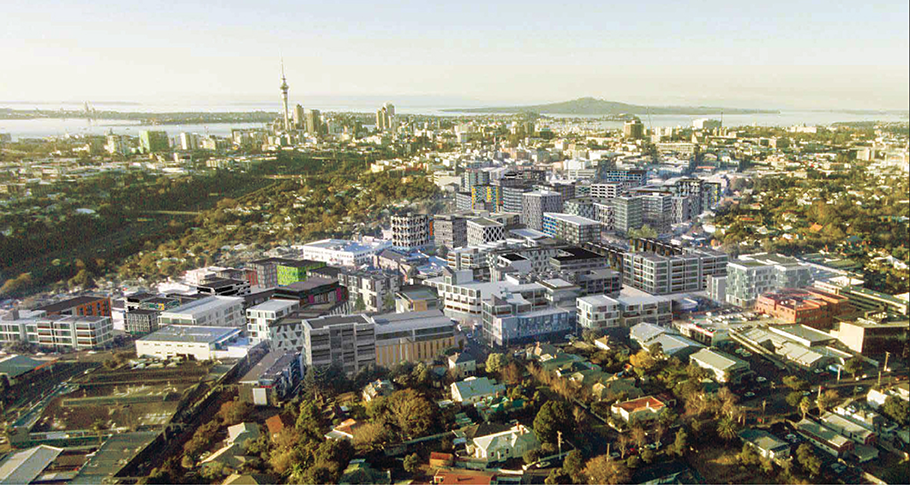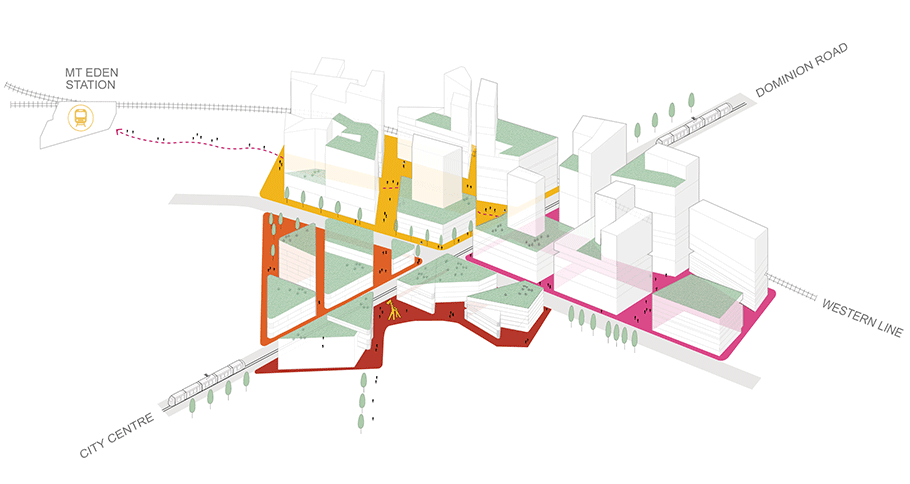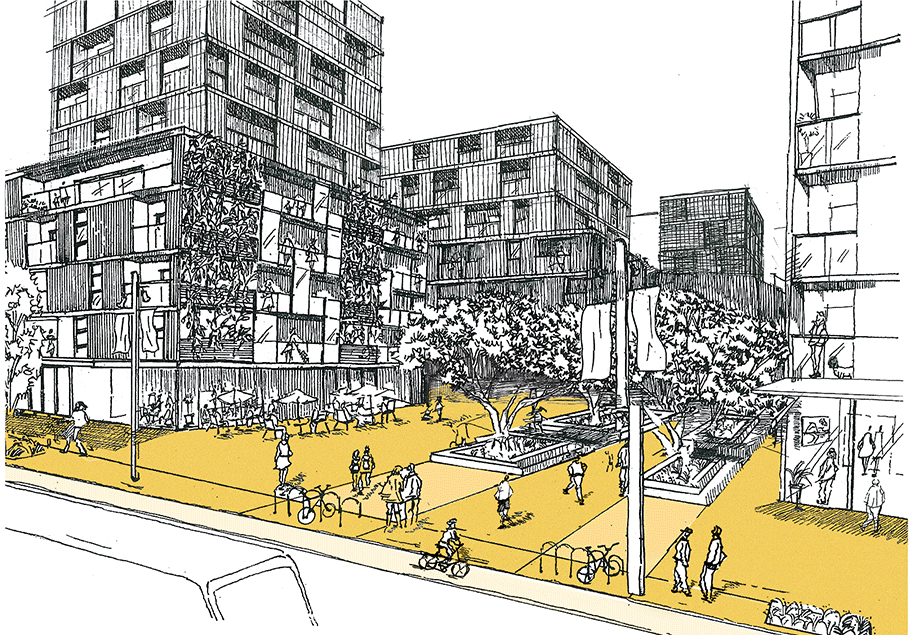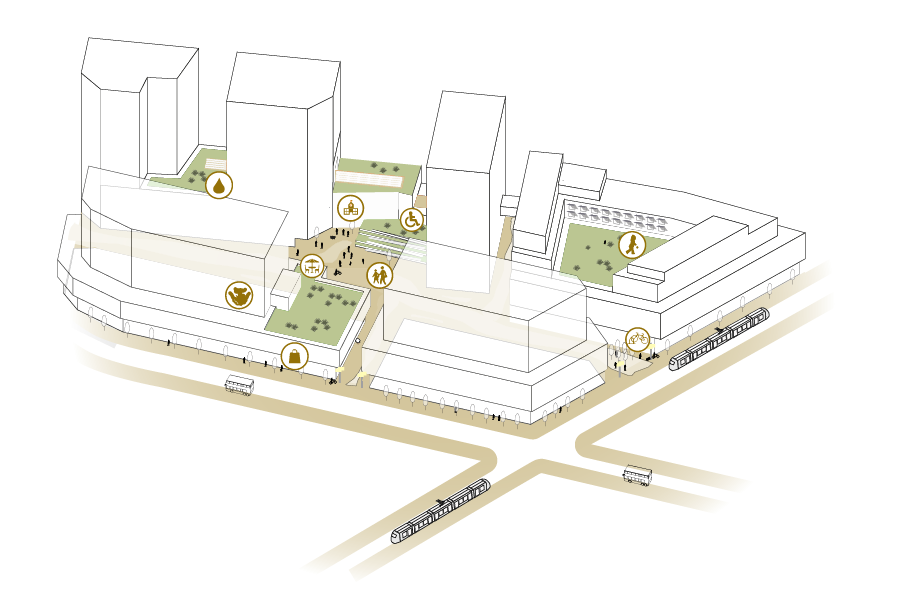Dominion Road Junction - creating a future urban neighbourhood

About this opportunity
The vision
A zero-carbon neighbourhood.
A diverse living and working community is accommodated around quick and easy access to trains, light rail and buses. Daily needs are within comfortable walking distance for most people, with healthy, active lifestyles supported by quality public spaces and strong walking and cycling connections.
Owning a car is unnecessary and parking is rarely needed.
A localised economy is nurtured, contributing to a sense of community and local identity.
Biodiversity is encouraged and water is respected as a taonga.
Located at a similar distance to the city centre as Parnell and Ponsonby, this site has the potential to define what a modern-day inner-city neighbourhood should be.

The opportunity
A transit oriented development (TOD)
Dominion Road Junction could accommodate tall buildings and a high-density neighbourhood. Enabled by proximity to the city centre and strong connectivity via high quality public transit (potentially light rail), walking and cycling routes, development here could deliver a mixed-use neighbourhood to support new and existing communities.
Optimise the public land holdings in the area
It will be crucial that the development of the public land holdings here and at Mount Eden are coordinated. A model for public stewardship of the land could be introduced to achieve the quality and long-term success of the development required. Enabling comprehensive development, with varied public spaces and building typologies, will help deliver zero carbon urban development.
Connections
This area will be well connected to the Mt Eden City Rail Link (CRL) station redevelopment, just 500m away - that’s about the length of Broadway in Newmarket or half of Queen Street. The result is two overlapping nodes of transit orientated developments.
While public transit will provide effortless and fast trips to the city centre, many people will choose to walk or cycle the short journey when Ian McKinnon Drive, New North Road and Upper Symonds Street are improved.
Remove the flyover to nowhere
The removal of the redundant motorway flyover, ‘right sizing’ of transport infrastructure and delivering a more humane public realm will address the severance issues and resultant urban blight in the area.
Upgrading the street network to prioritise people, improving wayfinding and creating new public spaces will enhance the quality of the public realm.
Safety will be improved through better visibility, legibility and street activation.
Compact urban growth
Greater intensification at the city fringe location of Dominion Road Junction can play a role in slowing the urban sprawl at the edge of the city and support our climate action.
It can reduce dependence on private vehicles, giving greater access to public transit and walking and cycling routes, greater access to jobs, services, amenities and health care.
It can also enable a more efficient use of public infrastructure funding and encourage more efficient use of privately owned assets.

New community
It could be possible to accommodate 8000 residents and 7500 workers in sustainably designed buildings and landscapes which reflect the unique Tāmaki Makaurau natural, human and cultural ecologies.
A new urban school could support families, enabling children living locally to walk to school.
The area could be developed as four quarters, centred on the new intersection, which come together to form the larger neighbourhood.
Each quarter could have its own internal places and spaces with accessible and child friendly pathways that connect them together.
Horizontal and vertical mixing of uses could align retail and commercial activities towards busier streets and ground floors, with residential above and in quieter areas.
Housing
A new neighbourhood could provide variety in housing to support individuals, couples and families. This could include multi-generational housing and apartments that can adapt to the changing needs of families.
Council owned land could provide social and affordable housing.
The area could support other alternative models of housing such as build-to-rent, or co-housing - where residents share amenities such as living space, gardens and other facilities.
It could also deliver urban papakāinga, allowing communal living in a contemporary Māori context.
Papakāinga allow for collective forms of living and provide the opportunity for greater economic independence and the expression of Māori social and cultural values.
Dominion Road Junction explained

- Water sensitive design through green roofs and infrastructure.
- Education and community facilities integrated into buildings.
- Universal design is embedded throughout.
- A flexible range of housing typologies and ownership models.
- Connected public and semi-public spaces provide play for children and opportunities to meet.
- Retail at ground floor to bring life to the street and provide for local needs.
- Commercial at level above for local employment.
- Strong pedestrian links between transport options and key attractions.
- Easy access to public transport such as light rail, buses and trains.





